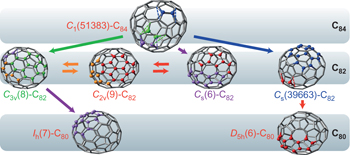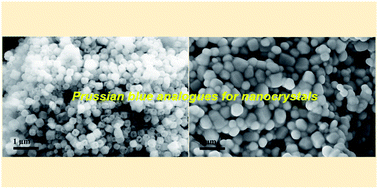
Shared posts
Influence of Chemisorbed Oxygen on the Growth of Graphene on Cu(100) by Chemical Vapor Deposition
Graphene-Based Polyaniline Nanocomposites: Preparation, Properties and Applications
DOI: 10.1039/C3TA13462H, Feature Article
Graphene is very popular in recent years, due to its unique electrical, thermal, mechanical, optical and electrochemical properties. With these useful advantages, graphene has been used as substance to incorporate...
The content of this RSS Feed (c) The Royal Society of Chemistry
Graphene Cryogel Paper with Enhanced Mechanical Strength for High Performance Lithium Battery
DOI: 10.1039/C3TA13660D, Paper
A porous graphene paper was prepared by pressing a graphene cryogel, followed by thermal reduction at 220[degree]C. The cryogel was formed by freeze-drying a solution containing chemically reduced graphene and...
The content of this RSS Feed (c) The Royal Society of Chemistry
Low Dimensional Carbon Materials for Applications in Mass and Energy Transport
Rational design of carbon network cross-linked Si-SiC hollow nanosphere as anode of lithium-ion batteries
DOI: 10.1039/C3NR04162J, Paper
A controllable route was developed to fabricate carbon cross-linked Si-SiC nanospheres as high-performance anode of lithium-ion batteries (LIBs).
The content of this RSS Feed (c) The Royal Society of Chemistry
Critical Crystal Growth of Graphene on Dielectric Substrates at Low Temperature for Electronic Devices.
Fabrication of High-Performance Flexible Alkaline Batteries by Implementing Multiwalled Carbon Nanotubes and Copolymer Separator

A flexible alkaline battery with multiwalled carbon nanotube (MWCNT) enhanced composite electrodes and polyvinyl alcohol (PVA)-poly (acrylic acid) (PAA) copolymer separator has been developed. Purified MWCNTs appear to be the most effective conductive additive, while the flexible copolymer separator not only enhances flexibility but also serves as electrolyte storage.
3D Nanocomposite Architectures from Carbon-Nanotube-Threaded Nanocrystals for High-Performance Electrochemical Energy Storage

Better electrode architecture: spherical assemblies of electrochemically active nanocrystals threaded with carbon nanotubes are made using a simple solvation-induced-assembly process. This architecture provides the composites with mechanical robustness, effective ion- and electron-transport pathways, enabling the fabrication of electrodes with high rate, high capacity, and long cycling stability.
Enhanced Lithium Ion Battery Cycling of Silicon Nanowire Anodes by Template Growth to Eliminate Silicon Underlayer Islands
Redox Cycling in Nanoporous Electrochemical Devices
DOI: 10.1039/C3NR03818A, Paper
Nanoscale redox cycling is a powerful technique for detecting electrochemically active molecules, based on fast repetitive oxidation and reduction reactions. An ideal implementation of redox cycling sensors can be realized...
The content of this RSS Feed (c) The Royal Society of Chemistry
Three-Dimensional Assembly of Single-Layered MoS2

Assembly of single layers: Three-dimensional assembly of single-layered MoS2 is achieved on a large scale via a solution method. The as-prepared tubular architectures have tunable size and mesopores in the shell, which are desirable for applications. As a example, they exhibit excellent lithium storage properties and are highly active for hydrodesulfurization of thiophene resulting from their structural advantages.
Carbon Nanotube – Reduced Graphene Oxide Composites for Thermal Energy Harvesting Applications

By controlling the SWNT-rGO electrode composition and thickness to attain the appropriate porosity and tortuosity, the electroactive surface area is maximized while rapid diffusion of the electrolyte through the electrode is maintained. This leads to an increase in exchange current density between the electrode and electrolyte which results in enhanced thermocell performance.
Hollow Carbon-Nanotube/Carbon-Nanofiber Hybrid Anodes for Li-Ion Batteries
Free-standing and Binder-free Sodium-ion Electrodes with Ultralong Cycle Life and High Rate Performance Based on Porous Carbon Nanofibers
DOI: 10.1039/C3NR05022J, Communication
Free-standing and binder-free porous carbon nanofibers (P-CNFs) electrodes were prepared by pyrolysis of PAN-F127/DMF nanofibers via electrospinning process as potential anodes for Na-ion batteries (NIB). The P-CNFs delivers a reversible...
The content of this RSS Feed (c) The Royal Society of Chemistry
Hybrid of Co3Sn2@Co Nanoparticles and Nitrogen-Doped Graphene as a Lithium Ion Battery Anode
25th Anniversary Article: Chemically Modified/Doped Carbon Nanotubes & Graphene for Optimized Nanostructures & Nanodevices
Outstanding pristine properties of carbon nanotubes and graphene have limited the scope for real-life applications without precise controllability of the material structures and properties. This invited article to celebrate the 25th anniversary of Advanced Materials reviews the current research status in the chemical modification/doping of carbon nanotubes and graphene and their relevant applications with optimized structures and properties. A broad aspect of specific correlations between chemical modification/doping schemes of the graphitic carbons with their novel tunable material properties is summarized. An overview of the practical benefits from chemical modification/doping, including the controllability of electronic energy level, charge carrier density, surface energy and surface reactivity for diverse advanced applications is presented, namely flexible electronics/optoelectronics, energy conversion/storage, nanocomposites, and environmental remediation, with a particular emphasis on their optimized interfacial structures and properties. Future research direction is also proposed to surpass existing technological bottlenecks and realize idealized graphitic carbon applications.

The current research status in the chemical modification/doping of carbon nanotubes and graphene is reviewed and their relevant applications in diverse areas, such as flexible electronics/optoelectronics, energy conversion/storage, nanocomposites and environmental remediation are discussed. An overview of specific correlations between chemical modification/doping of the graphitic carbons with their tunable material properties is presented, which offers research direction to realize idealized graphitic carbon nanostructures in future advanced applications.
Review on measurement techniques of transport properties of nanowires
DOI: 10.1039/C3NR03242F, Review Article
Physical properties at the nanoscale are novel and different from those in bulk materials.
To cite this article before page numbers are assigned, use the DOI form of citation above.
The content of this RSS Feed (c) The Royal Society of Chemistry
Disproportionation in Li–O2 Batteries Based on a Large Surface Area Carbon Cathode
Two-phase versus two-stage versus multi-phase lithiation kinetics in silicon
We classify the lithiation process into three types, namely, two-phase, two-stage, and multi-phase lithiation. We found that under a given charging rate, smaller electrochemical Biot number of β will likely to result in two-phase lithiation, while larger β may lead to multi-phase lithiation. For t ... [Appl. Phys. Lett. 103, 143901 (2013)] published Tue Oct 01, 2013.
Hierarchical Porous Graphene/Polyaniline Composite Film with Superior Rate Performance for Flexible Supercapacitors

A highly flexible graphene free-standing film with hierarchical structure is prepared by a facile template method. With a porous structure, the film can be easily bent and cut, and forms a composite with another material as a scaffold. The 3D graphene film exhibits excellent rate capability and its capacitance is further improved by forming a composite with polyaniline nanowire arrays. The flexible hierarchical composite proves to be an excellent electrode material for flexible supercapacitors.
Growth of linked silicon/carbon nanospheres on copper substrate as integrated electrodes for Li-ion batteries
DOI: 10.1039/C3NR04323A, Paper
We report the growth of linked silicon/carbon (Si/C) nanospheres on Cu substrate as an integrated anode for Li-ion batteries. The Si/C nanospheres were synthesized by a catalytic chemical vapor deposition...
The content of this RSS Feed (c) The Royal Society of Chemistry
Multilayered Si Nanoparticle/Reduced Graphene Oxide Hybrid as a High-Performance Lithium-Ion Battery Anode

Multilayered Si/RGO anode nanostructures, featuring alternating Si nanoparticle (NP) and RGO layers, good mechanical stability, and high electrical conductivity, allow Si NPs to easily expand between RGO layers, thereby leading to high reversible capacity up to 2300 mAh g−1 at 0.05 C (120 mA g−1) and 87% capacity retention (up to 630 mAh g−1) at 10 C after 152 cycles.
Highly robust silicon nanowire/graphene core-shell electrodes without polymeric binders
DOI: 10.1039/C3NR00852E, Paper
We report on a novel method to fabricate binder-free graphene encapsulated silicon nanowires via hot pressing without the use of conventional polymer binders or carbon black for lithium ion battery anodes.
The content of this RSS Feed (c) The Royal Society of Chemistry
Synthesis of nanostructured materials by using metal-cyanide coordination polymers and their lithium storage properties
DOI: 10.1039/C3NR03289B, Paper
A Prussian blue analogue has been explored as a novel precursor for large scale synthesis of nanostructured LiCoO2 single crystalline and porous Fe2O3@NixCo3-xO4 nanocubes. The as-derived nanocrystals exhibit excellent lithium storage properties when used as electrode materials for Li-ion batteries.
The content of this RSS Feed (c) The Royal Society of Chemistry
In Situ Atomic Force Microscopy of Lithiation and Delithiation of Silicon Nanostructures for Lithium Ion Batteries
A missing link in the transformation from asymmetric to symmetric metallofullerene cages implies a top-down fullerene formation mechanism

Nature Chemistry. doi:10.1038/nchem.1748
Authors: Jianyuan Zhang, Faye L. Bowles, Daniel W. Bearden, W. Keith Ray, Tim Fuhrer, Youqing Ye, Caitlyn Dixon, Kim Harich, Richard F. Helm, Marilyn M. Olmstead, Alan L. Balch & Harry C. Dorn
An asymmetric pentalene-containing C1(51383)-C84 fullerene cage is found in two different metal carbide metallofullerenes. This particular cage can, in simple steps, rearrange into many well-known fullerene cages that are more stable and more symmetric, suggesting it is likely that metallofullerenes are generated by a ‘top-down’ formation mechanism.
Supercapacitors: Bacterial-Cellulose-Derived Carbon Nanofiber@MnO2 and Nitrogen-Doped Carbon Nanofiber Electrode Materials: An Asymmetric Supercapacitor with High Energy and Power Density (Adv. Mater. 34/2013)

A new kind of high-performance asymmetric supercapacitor is designed with pyrolyzed bacterial cellulose (p-BC)-coated MnO2 as the positive electrode material and nitrogen-doped p-BC as the negative electrode material, via an easy, efficient, large-scale, and green fabrication approach as described by Shu-Hong Yu and co-workers, on page 4746. The optimal asymmetric device possesses an excellent supercapacitive behavior with quite high energy and power density.
Temperature Dependence of Catalyst-Free Chirality-Controlled Single-Walled Carbon Nanotube Growth from Organic Templates
Flexible Nanodielectric Materials with High Permittivity for Power Energy Storage
Study of flexible nanodielectric materials (FNDMs) with high permittivity is one of the most active academic research areas in advanced functional materials. FNDMs with excellent dielectric properties are demonstrated to show great promise as energy-storage dielectric layers in high-performance capacitors. These materials, in common, consist of nanoscale particles dispersed into a flexible polymer matrix so that both the physical/chemical characteristics of the nanoparticles and the interaction between the nanoparticles and the polymers have crucial effects on the microstructures and final properties. This review first outlines the crucial issues in the nanodielectric field and then focuses on recent remarkable research developments in the fabrication of FNDMs with special constitutents, molecular structures, and microstructures. Possible reasons for several persistent issues are analyzed and the general strategies to realize FNDMs with excellent integral properties are summarized. The review further highlights some exciting examples of these FNDMs for power-energy-storage applications.

Recent progress in the development of flexible nanodielectric materials (FNDMs) with high dielectric permittivity is highlighted. Particular focus is given to increasing the energy density of various FNDMs. Key issuses in the synthesis, structure, and dielectric properties of nanodielectrics are reviewed. Some long-standing problems and topics that warrant further investigation are also addressed.










